Saudi Arabia is the largest country in the Middle East.
Home to an estimated 0.46% of the global population, it is the 41st most populous country in the world.
But what constitutes its population?
Are expatriates in the majority or natives?
Do males have a higher representation or females?
Let’s find out.
Here, in this blog, we will examine the population statistics of Saudi Arabia as of 2025.
Saudi Population 2025 – Key Statistics
As of May 2025, Saudi Arabia’s population is 36.96 million, based on data collected by the GMI team. This number reflects the total number of people currently living in the country, including both Saudi citizens and expatriates
The population density of Saudi Arabia in 2025 is 16.10 people per square kilometer.
The male population in Saudi Arabia 2025 is 22.95 Million
The female population in Saudi Arabia 2025 is 14.01 Million
The urban population in Saudi Arabia 2025 is 31.77 Million
The median age in 2025 is approximately 29.6 years.
Riyadh is the most populated city in Saudi Arabia with 7.95 million people
Islam is the most practised religion in Saudi Arabia with 34.37 million followers
Saudi Population – An Overview
The Saudi Arabian population has grown significantly in recent years.
According to the 2022 census, the population was 32.12 million.
As of May 2025, the population of Saudi Arabia has increased to 36.96 million.
The population density in 2025 is 16.10 people per square kilometer, and the median age is approximately 29.6 years.
Saudi Arabia – Country in a nutshell

Saudi Arabia (Kingdom of Saudi Arabia) is a country with deep historical roots.
Revered by Muslims worldwide, KSA is home to the famous mosques Mecca and Medina, two of the most visited pilgrimage centers on earth.
KSA is divided into 13 provinces.
Each province has a governor, a deputy governor, and a provincial council.
These provinces are further subdivided into 118 governorates.
Until the middle of the 20th century, Saudi Arabia followed a traditional lifestyle.
With the rise of the Saud family (Al Sa Ud), the country began to witness transformations on all fronts.
Innovations in the field of transportation and technology fuelled more international relations.
With the massive financial growth brought about by petroleum resources, the country is now the 18th richest GDP in the world.
Today, in line with its “Vision 2030”, the country is actively working towards diversifying its oil-based economy and providing its people with more and varied economic and cultural opportunities.
This has led to a large influx of expats from all over the world, significantly changing the demographics of the region.
Saudi Arabia Population Statistics 2025 [Infographics]

Saudi Arabia’s Demographics in 2025
Saudi Arabia is home to a diverse and growing population.
The next sections explore key demographic factors shaping the country.
Gender Distribution
Gender | Population | Population (%) |
Male | 22.95 Million | 62.08% |
Female | 14.01 Million | 37.92% |
Saudi Arabia’s population remains male-dominated, with 62.08% men (22.95 million) and 37.92% women (14.01 million).
While the gender gap is gradually narrowing, there is still a noticeable difference between the number of men and women.
This trend has historically been shaped by cultural norms and economic factors, including the large number of male expatriates working in key industries.
However, the Saudi government is actively working to empower women through initiatives that encourage higher university enrollment and workforce participation.
These efforts are slowly shifting the gender balance and contributing to the Kingdom’s broader modernization goals.
As more women enter the workforce, these changes could have a significant impact on society and the economy in the coming years.
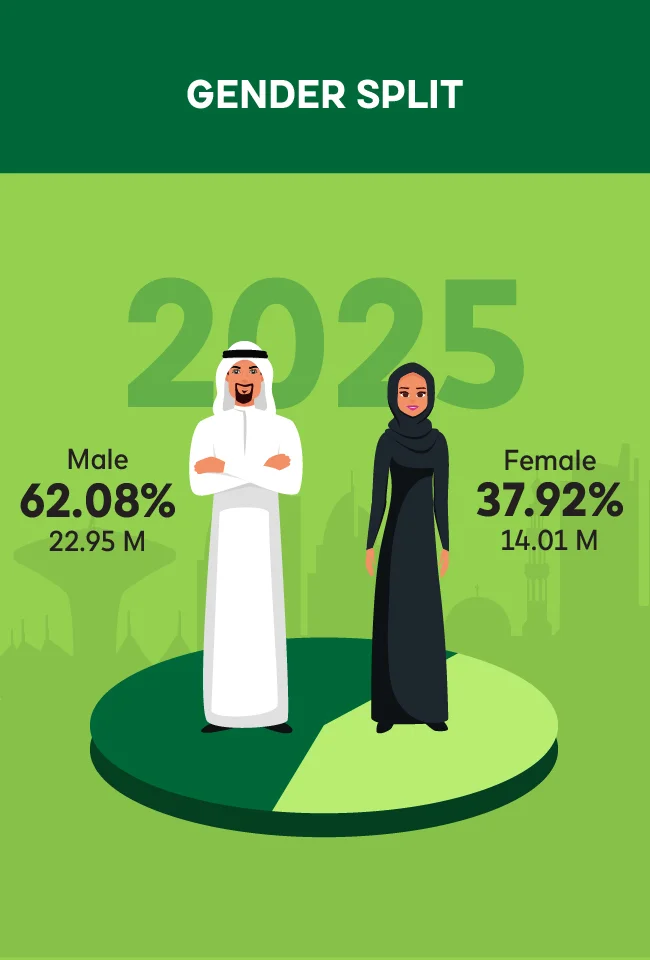
Saudi Arabia Population by Age (2025)
Age Group | Population | Population (%) |
0-14 years | 8.30 Million | 22.46% |
15-24 years | 5.64 Million | 15.25% |
25-54 years | 20.09 Million | 54.36% |
55-64 years | 1.90 Million | 5.14% |
65 years and above | 1.03 Million | 2.79% |
✨ The largest age group is 25-54 years, making up 54.36% (20.09 million people). This indicates a strong working-age population that drives the economy.
👶 The second-largest group is children (0-14 years) at 22.46% (8.30 million people), highlighting a young and growing demographic.
🧑🎓 Young adults (15-24 years) make up 15.25% (5.64 million people), representing the future workforce.
🔴 The population declines significantly in older age groups.
Ages 55-64 account for 5.14% (1.90 million people)
Seniors (65+ years) make up just 2.79% (1.03 million people)
This distribution suggests that Saudi Arabia has a youthful population, which could shape its economy, labor market, and social policies in the coming years.
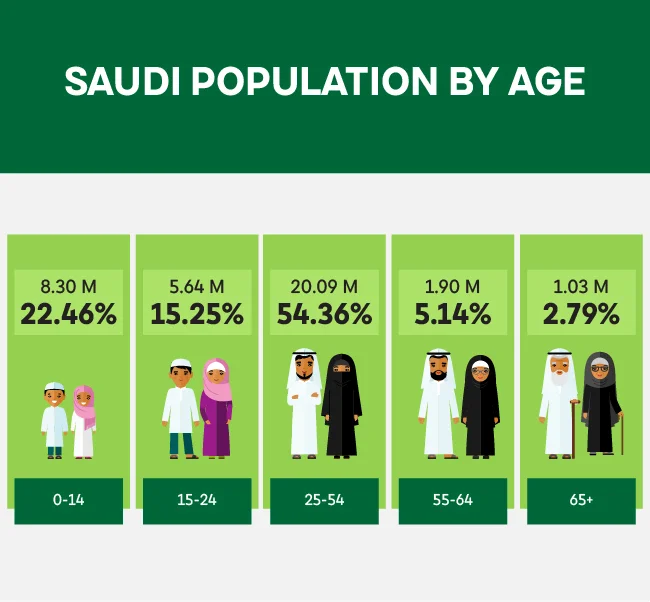
Saudi Arabia’s Population by Gender (2025)
Age Group | Men | Women |
0-14 years | 4.21 Million | 4.09 Million |
15-24 years | 3.24 Million | 2.39 Million |
25-54 years | 13.72 Million | 6.37 Million |
55-64 years | 1.21 Million | 0.70 Million |
65 years and above | 0.56 Million | 0.47 Million |
✨ The 25-54 age group has the highest population, with 13.72 million men and 6.37 million women, indicating a strong working-age population. The higher number of men is likely due to labor migration in key industries.
👶 Among children (0-14 years), the numbers are almost equal, with 4.21 million boys and 4.09 million girls. This suggests a stable birth rate across genders.
🧑🎓 In the 15-24 age group, there are more men (3.24 million) than women (2.39 million). This could be due to higher education or employment opportunities available to young men.
🔴 The 55-64 age group sees a decline in population, with 1.21 million men and 0.70 million women. The gender gap remains, but both numbers decrease as people approach retirement age.
💔 The 65+ age group has the lowest population, with 0.56 million men and 0.47 million women. The narrowing gender gap here suggests that women may have a slightly higher life expectancy than men in Saudi Arabia.
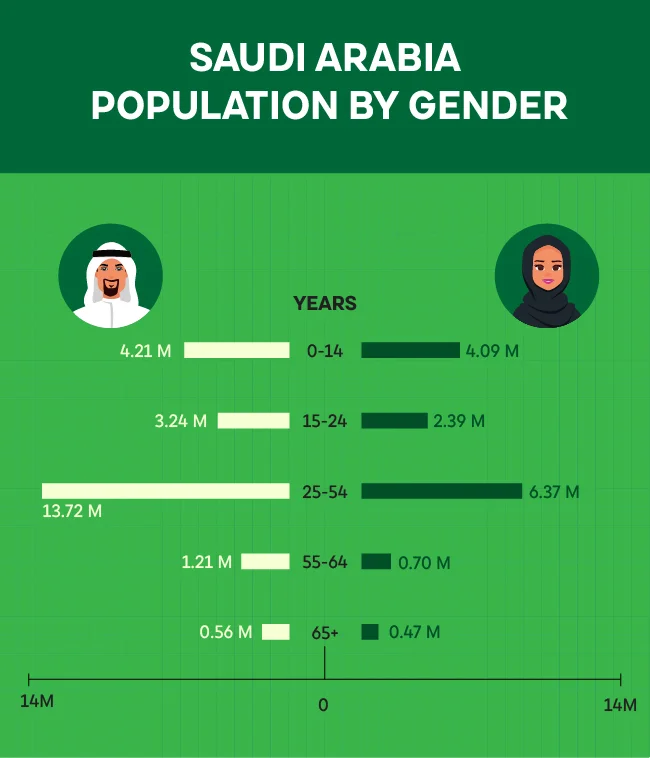
Saudi Arabia’s Population by Year (2010 – 2025)
| Year |
Population |
2025 | 36.96 Million |
2024 | 35.50 Million |
2023 | 33.26 Million |
2022 | 32.18 Million |
2021 | 31.33 Million |
2020 | 30.99 Million |
2015 | 29.97 Million |
2010 | 25.16 Million |
Saudi Arabia’s population has been steadily growing over the years, reaching 36.96 million in 2025.
Between 2020 and 2025, the country added nearly 6 million people, reflecting significant growth.
The most noticeable increase happened between 2023 and 2025, when the population jumped by 3.7 million in just two years.
Looking back further, since 2015 (29.97 million), the population has grown by almost 7 million in a decade.
Historically, Saudi Arabia saw rapid population growth in the second half of the 20th century, thanks to improved healthcare and better living conditions.
A declining death rate and higher life expectancy played a major role in this rise.
According to United Nations projections, the population will continue to grow, though at a slower pace in the coming years.
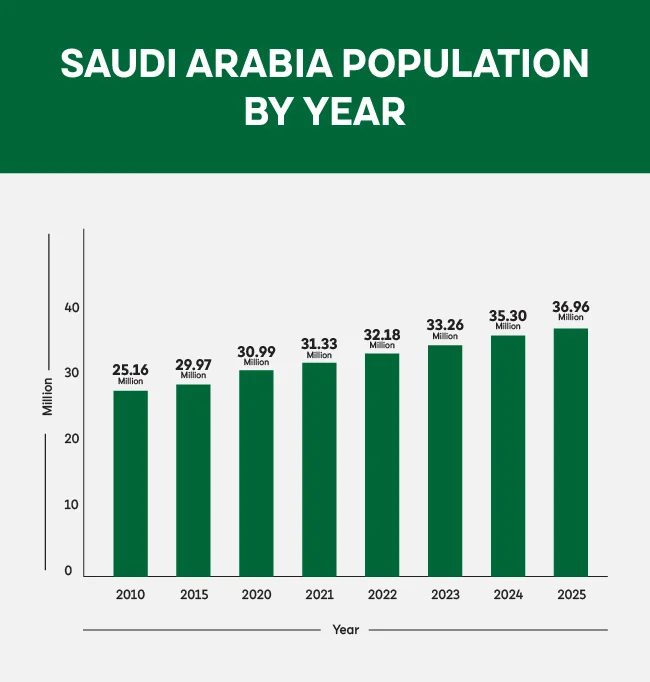
Saudi vs. Non-Saudi Population in Saudi Arabia 2025
Nationality | Percentage | Population |
Saudi Nationals | 55.6% | 20.55 Million |
Non-Saudis | 44.4% | 16.41 Million |
According to research by the GMI Team, Saudi Arabia’s population consists of both nationals and expatriates, reflecting its economic strength and international workforce.
✅ Saudi nationals account for 55.6% (20.55 million people), primarily engaged in government, business, and public services.
🌍 Non-Saudis, making up 44.4% (16.41 million people), are mainly foreign workers contributing to sectors like construction, healthcare, retail, and IT.
The significant presence of expatriates highlights Saudi Arabia’s role as a global economic hub, while initiatives like “Saudization” (Nitaqat) focus on boosting local employment.
This blend of locals and expatriates plays a crucial role in shaping the country’s workforce diversity and economic growth.
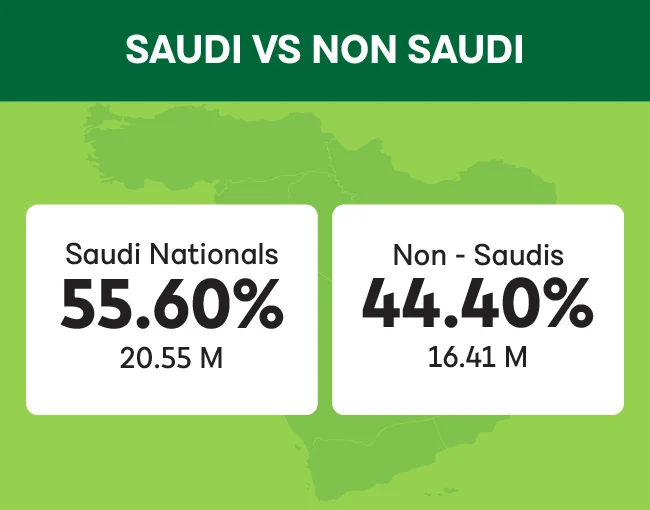
Saudi Population by Nationality 2025
Nationality | Male Population (In Million) | Female Population (In Million) | Total Population (In Million) |
|---|---|---|---|
Bangladesh | 2.39 | 0.20 | 2.59 |
India | 2.10 | 0.21 | 2.31 |
Pakistan | 2.02 | 0.20 | 2.23 |
Yemen | 1.64 | 0.58 | 2.21 |
Egypt | 1.45 | 0.36 | 1.80 |
Sudan | 0.83 | 0.18 | 1.00 |
Philippines | 0.34 | 0.55 | 0.89 |
Syrian Arab Republic | 0.32 | 0.23 | 0.55 |
Nepal | 0.36 | 0.01 | 0.36 |
Jordan | 0.14 | 0.11 | 0.25 |
Indonesia | 0.05 | 0.16 | 0.22 |
Myanmar | 0.11 | 0.09 | 0.20 |
Ethiopia | 0.05 | 0.14 | 0.20 |
Afghanistan | 0.12 | 0.05 | 0.16 |
Others | 0.65 | 0.78 | 1.43 |
The GMI Team has analyzed the expatriate population in Saudi Arabia, revealing a diverse workforce contributing to the country’s economic growth.
✔ Bangladesh tops the list with 2.59 million expats, the majority (2.39 million) being men, reflecting strong labor migration.
✔ India follows with 2.31 million people, again dominated by male workers, primarily in construction, healthcare, and trade.
✔ Pakistan has 2.23 million expats, contributing significantly to various industries across the kingdom.
⭐ Yemen’s 2.21 million expats include a relatively higher number of female workers than other nationalities.
⭐ Egypt (1.80 million) and Sudan (1.00 million) play vital roles in professional sectors like education and healthcare.
⭐ The Philippines has 0.89 million expats, with more women than men, largely working in domestic and medical services.
⭐ Other communities, including Syrians, Nepalis, Jordanians, Indonesians, Ethiopians, and Afghans, form smaller but essential segments of the workforce.
This data highlights Saudi Arabia’s status as a key global employment hub, attracting workers from Asia, the Middle East, and Africa.
These expatriates continue to drive growth in construction, trade, and service industries, reinforcing their crucial role in the kingdom’s economic landscape.

Saudi Arabia Birth Rate, Death Rate & Immigration Rate 2025
Births | 1547/Day | 55.9 Seconds |
Deaths | 220/Day | 6.50 Minutes |
Immigrations | 328/Day | 4.40 Minutes |
Saudi Arabia records 1,547 births per day, which means there is a birth every 55.9 seconds.
The high number of births aligns with a youthful population and relatively high fertility rates.
Improved healthcare and living standards contribute to a lower daily death rate of 220, allowing more people to reach an older age.
Meanwhile, strong economic opportunities in urban centers, driven by oil revenues and rapid infrastructure development, attract around 328 immigrants each day.
Together, these factors explain Saudi Arabia’s dynamic population growth.

Population in Main Cities of Saudi Arabia 2025
|
City |
Population |
|
Riyadh | 7.95 Million |
|
Jeddah | 5.02 Million |
|
Mecca | 2.22 Million |
|
Medina | 1.63 Million |
Ad-Dammam | 1.38 Million |
|
Taif | 0.73 Million |
|
Tabuk | 0.71 Million |
Riyadh, the capital and administrative center of Saudi Arabia, is home to 7.95 million people. Its population growth is fueled by booming business, government institutions, and rapid urban development.
Jeddah, with 5.02 million residents, is a major port city on the Red Sea. Its strategic location supports trade and tourism, making it a key economic hub.
Mecca, housing 2.22 million people, is the holiest city in Islam. It attracts millions of visitors each year, contributing to a stable local population.
Medina, with 1.63 million residents, is revered for its Islamic heritage. It draws both pilgrims and permanent residents, thanks to its religious significance.
Ad-Dammam, home to 1.38 million people, is a major hub for the oil industry and commerce, playing a crucial role in the country’s economy.
Taif, with a population of 0.73 million, is known for its cooler climate and agricultural production, making it a unique destination in Saudi Arabia.
Tabuk, with 0.71 million residents, holds historical and strategic importance. It serves as a gateway to northwestern Saudi Arabia and is vital for regional development.
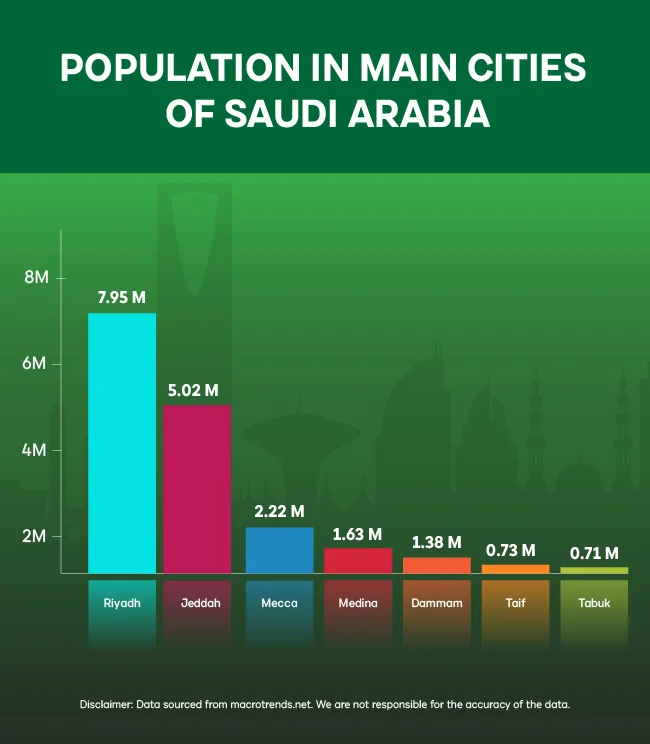
⚠️ Disclaimer: Data sourced from macrotrends.net. We are not responsible for the accuracy of the data.
Saudi Arabia Population 2025 (Urban vs Rural)
Urban | 31.53 Million | 85.30% |
Rural | 5.43 Million | 14.70% |
Saudi Arabia’s population is predominantly urban, with 85.3% (31.53 million people) living in cities. This shift is largely due to better job opportunities, modern infrastructure, and improved quality of life found in urban areas.
In contrast, only 14.7% (5.43 million people) reside in rural areas. This significant gap highlights how economic growth and development have been concentrated in cities, making them more attractive for residents seeking prosperity and modern amenities.
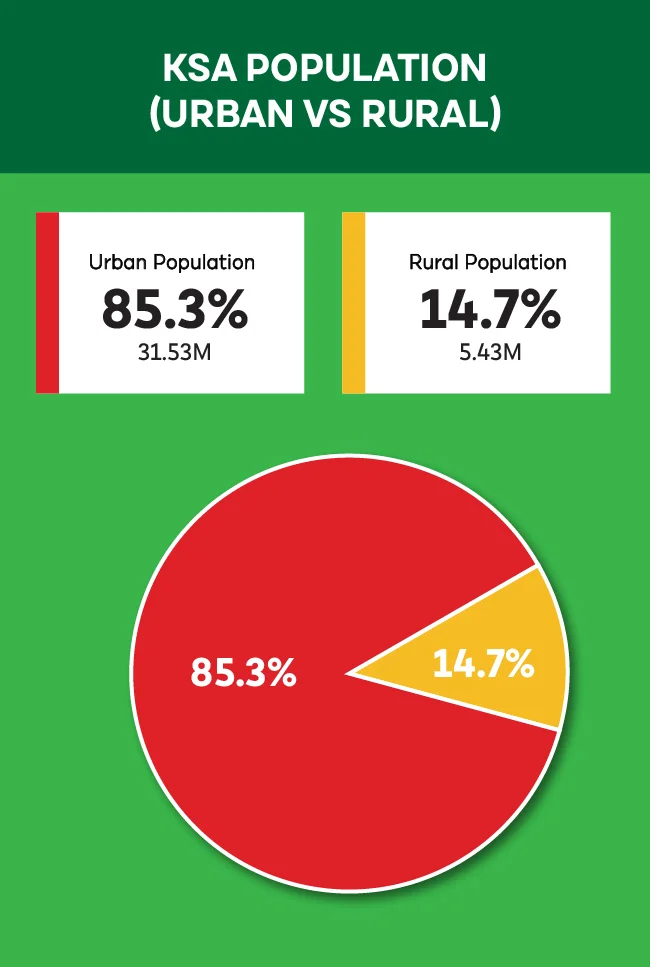
Saudi Arabia Population by Religion 2025
Religion | Percentage | Population (in Million) |
Islam | 93% | 34.37 M |
Christianity | 4.4% | 1.63 M |
Hinduism | 1.1% | 0.41 M |
Religiously Unaffiliated | 0.7% | 0.26 M |
Folk or traditional religions | 0.3% | 0.11 M |
Buddhism | 0.3% | 0.11 M |
Others | 0.2% | 0.07 M |
Islam is the dominant religion in Saudi Arabia, with 93% of the population (34.37 million people) identifying as Muslim. This strong majority underscores the deep influence of Islamic traditions and values in the country’s culture, laws, and daily life.
Christianity is the second-largest religion, making up 4.4% (1.63 million people). This reflects a small but notable Christian community, primarily consisting of expatriates.
Hinduism accounts for 1.1% (0.41 million people), followed by the religiously unaffiliated (0.7%), and smaller groups practicing folk religions, Buddhism, and other faiths.
While Islamic traditions shape the nation, the presence of diverse minority communities contributes to Saudi Arabia’s cultural landscape, reflecting its role as a global economic hub with a significant expatriate population.
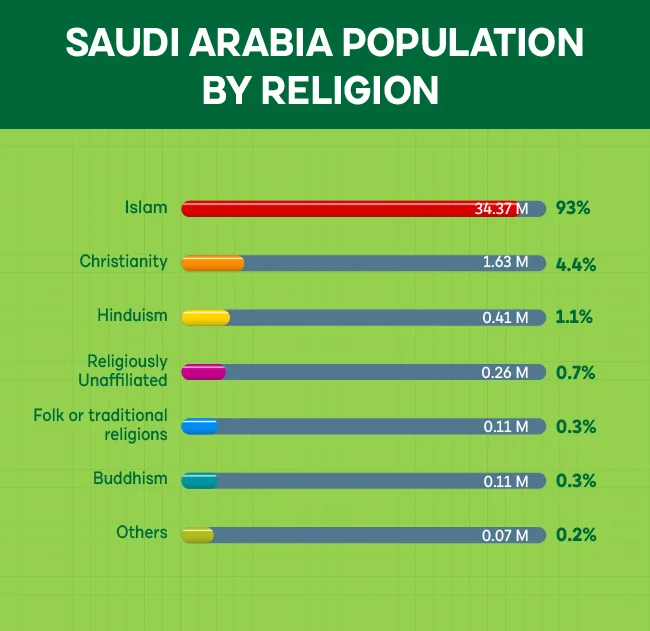
Conclusion
Saudi Arabia’s population growth is a testament to its economic strength, cultural heritage, and ongoing modernization.
With a young and largely urban population, the country is evolving while staying true to its traditions.
The gender gap is gradually closing as more women enter the workforce, and urbanization continues to shape daily life.
As the Kingdom pushes forward with Vision 2030, these demographic shifts will play a key role in shaping its future.
Keeping an eye on these changes helps us better understand Saudi Arabia’s social and economic journey.
For a wider perspective, our detailed GCC population statistics provide valuable insights into how Saudi Arabia’s trends compare within the region.
⚠️ Disclaimer & Note: This content is for general informational purposes only. We are not responsible for any errors, financial loss, or damages that may result from its use or reliance. Please verify the information with official sources as needed. Also, please note that population figures may vary slightly as they are updated from multiple sources.
Now, let’s look at the KSA population statistics 2022 census data
Saudi Population Government Census – Key Statistics
According to the 2022 census, the total population of KSA is 32.12 million.
The median age is 29 years.
The fertility rate is 2.8.
The Saudi dependency ratio is 62.
Of the total population, 58.4% are Saudis, while 41.6% are non-Saudis.
Males make up 61.2% of the population, while females make up 38.8% of the population.
The average household size of Saudis is 4.8, while the average household size of non-Saudis is 2.7.
Indian population in Saudi Arabia 2023 is 1.88 Million according to 2022 Saudi census.
Now, let us examine the some of the important findings from the KSA 2022 Census in detail:
Saudi Population Government Census – Infographics

Gender Split
| Gender | Population | Percentage |
| Male | 19.70 Million | 61.20% |
| Female | 12.50 Million | 38.80% |
There is a clear gender disparity in the population, with males outnumbering females. There are 19.70 million males compared to 12.50 million females in Saudi Arabia.
However, Saudi Arabia is actively taking proactive steps to bridge this gap, including Vision 2030, which focuses on providing more socio-economic opportunities to women. Till now, the initiatives have resulted in the following opportunities for females: the right to drive and obtain passports, jobs in the military and armed forces, giving them the right to property, etc. These decisions reflect the nation’s commitment to creating a more inclusive society.
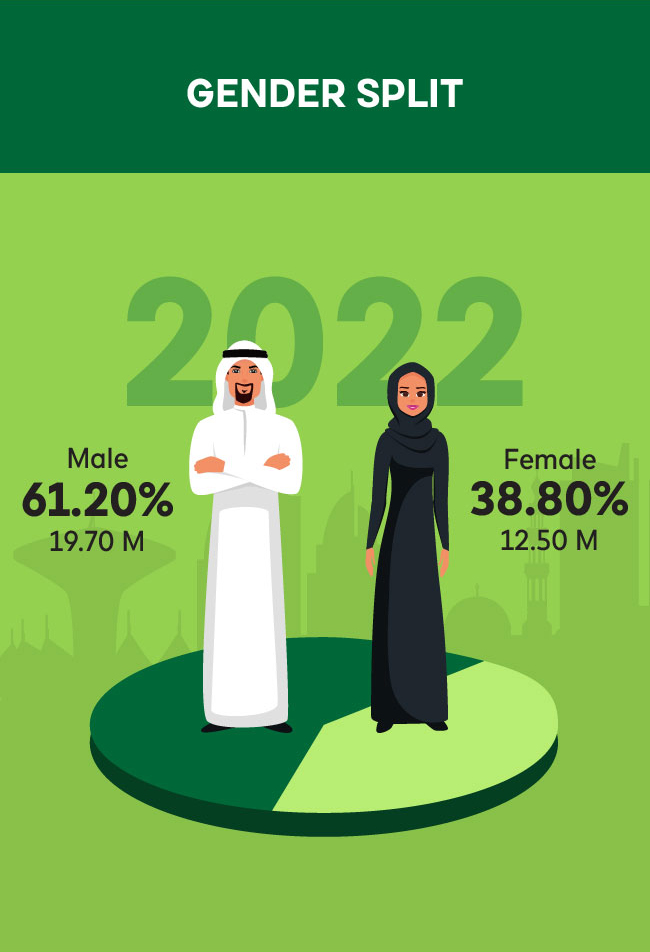
Nationality Split
| Nationality | Population | Percentage |
| Saudi | 18.80 Million | 58.40% |
| Non Saudi | 13.40 Million | 41.60% |
When it comes to the nationality split, Saudi nationals dominate the country with a total of 18.8 million, while non-Saudis account for only 13.4 million of the total population.
This can be attributed to the fact that Saudis have excellent opportunities within the country, thanks to Nitaqat or Saudization programmes. In addition, the Saudis also receive many economic incentives, including healthcare, housing, education, etc.
All of this significantly helps KSA retain its nationals, even though many sectors such as construction, healthcare, etc., rely on migrant workers.
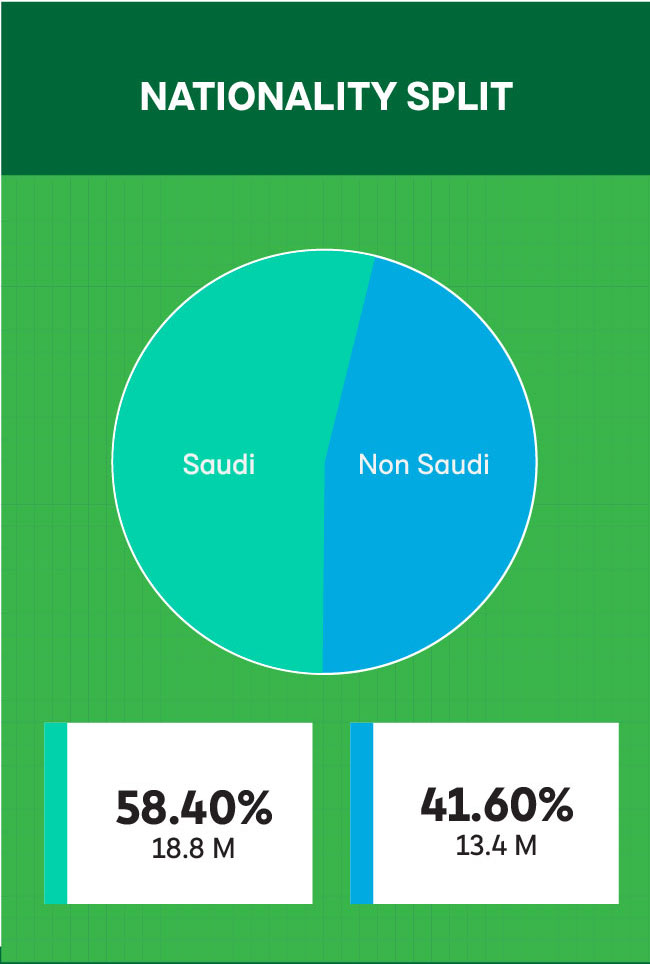
Saudi Population by Age
| Age Group | Population | Percentage |
| 0-14 Years | 7.89 Million | 24.51% |
| 15-19 Years | 2.20 Million | 6.83% |
| 20-24 Years | 2.62 Million | 8.13% |
| 25-54 Years | 16.97 Million | 52.75% |
| 55-64 Years | 1.64 Million | 5.11% |
| 65-69 Years | 0.37 Million | 1.15% |
| 70-74 Years | 0.21 Million | 0.64% |
| 75+ Years | 0.29 Million | 0.90% |
When we examine the age-wise demographics of the KSA population, the age group 25-54 years constitute the majority. They account for 16.97 million or 52.75% of the population. This is the prime working age population of KSA, or the driving force of the KSA economy.
On the other hand, the lowest percentage of people is found in the 70-74 age group, comprising 0.21 million people or 0.64% of the total population.
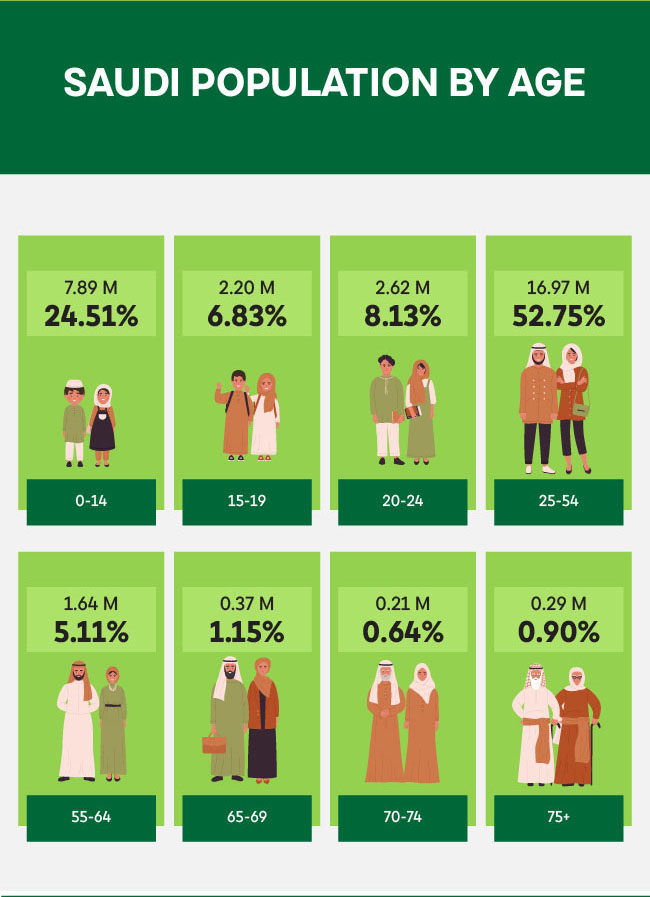
Saudi Population By Nationality
| Nationality | Population | Male | Female |
| Bangladesh | 2.12 Million | 1.95 Million | 0.17 Million |
| India | 1.88 Million | 1.71 Million | 0.17 Million |
| Pakistan | 1.81 Million | 1.65 Million | 0.16 Million |
| Yemen | 1.80 Million | 1.33 Million | 0.47 Million |
| Egypt | 1.47 Million | 1.18 Million | 0.29 Million |
| Sudan | 0.82 Million | 0.67 Million | 0.15 Million |
| Philippines | 0.73 Million | 0.27 Million | 0.46 Million |
| Syrian Arab Republic | 0.45 Million | 0.26 Million | 0.19 Million |
| Nepal | 0.30 Million | 0.29 Million | 0.01 Million |
| Jordan | 0.20 Million | 0.11 Million | 0.09 Million |
| Indonesia | 0.18 Million | 0.05 Million | 0.13 Million |
| Myanmar | 0.16 Million | 0.09 Million | 0.07 Million |
| Ethiopia | 0.16 Million | 0.04 Million | 0.12 Million |
| Afghanistan | 0.13 Million | 0.09 Million | 0.04 Million |
| Others | 1.17 Million | 0.53 Million | 0.64 Million |
According to the latest KSA census report released in May 2023, out of the total expat population of 41.6%, Bangladeshi nationals occupy the first position with 2.12 million people. Of these, 1.95 million are males and 0.17 million are females. The second position is occupied by Indians, with 1.88 million in which 1.71 million are males and 0.17 million are females. The third position is occupied by Pakistani nations with 1.81 million,where 1.65 million are males and 0.16 million are females.

Saudi Population Forecasts/Predictions
Based on births, deaths, and migrations, the KSA’s population increases by one person every 59 seconds. And according to some sources, the population of the country is expected to reach 39.93 million by 2027.
Saudi Arabia is in its early stages of social and economic development. Many societal changes including issuing driving rights to women and opening the borders to tourists other than Haj pilgrims show that the country is expanding its horizons. This can bring about a change in the country’s demographics and the overall population in the coming years.
To get your brands message to your clients in Saudi Arabia or abroad get in touch with Global Media Insight today. We have over 24 years of experience in digital technologies and social media and digital markets along with expertise on the latest tools to drive engagement to increase your business brand value and customer loyalty. Talk to us to discover social media strategies that work across platforms and channels.
Disclaimer: GMI acknowledges that though we try to report accurately, we cannot verify the absolute facts of everything that has been presented in this blog. The information presented is based on information researched from various sources on the internet. We are not liable for any errors, financial loss, or damages of any kind that may result from the use of, or reliance on, the information herein.

GMI’s Research Team is a panel of knowledgeable experts from various fields such as digital marketing, social media, and web development, all united by a common goal—to educate. We enjoy exploring everything from the latest industry trends and emerging technologies to people and demographics, both in the UAE and beyond. Through our blog posts, we share valuable insights that help businesses and marketers stay informed and prepared for the challenges and opportunities that lie ahead.









